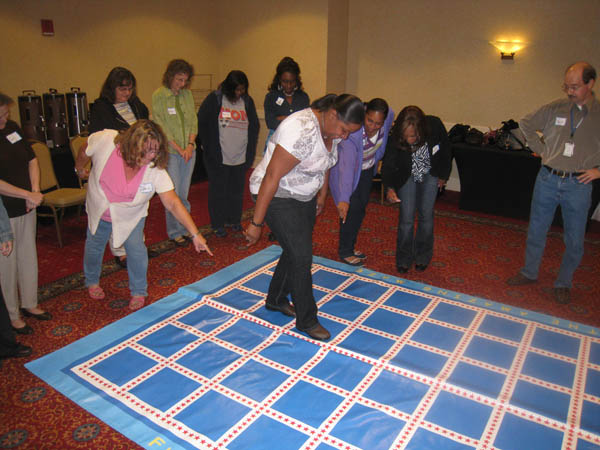
During the summer months, educators recharge their zeal for teaching by participating in meaningful staff development for teachers. However, to get the most of this nurturing self discovery, teachers must be hands-on during the process or be left zoning out and feeling like their time has been wasted, yet again. One way to maximize the teaching team building experience is with experiential learning activities.
But first, to understand the power of learning through experiences, it is important to understand that humans learn in different ways. Where one would like to see a problem in “black and white”, another retains information better when it is verbally explained to them. No Matter what the preferred way is, it is important to embrace the fact that there are three basic ways people learn.
Three Ways of Learning
Just like educators must learn the best ways their students learn to get the desired results in the classroom, team building activities or summer teacher workshops must adhere to this fact as well. During this scenario, the roles are “reversed”, teacher becomes “student” and has a unique learning needs as a result.
There are three types of learning styles:
- Visual
- Auditory
- Kinesthetic
Visual
Visual learners remember 75% of what they read or SEE. Visual learners prefer the use of images, maps, and storyboards to understand new information. The best way to facilitate learning for a visual learner is to avoid rote memorization and a reliance on verbal instruction only. In general, the visual learner has a hard time remembering verbal instruction and needs to know the overall view or goal before beginning a task
To get the best participation out of a visual learner during team building activities, it is important to provide:
- Written instruction
- Charts/white boards to display written goals/objectives for each session/activity
- Opportunity for the visual learner to take notes, if so desired
- Activities or team building exercises that enable the participants to write down answers or solutions
Seeing is not always believing. When considering an auditory learner, the approach is markedly different.
Auditory
Where the visual learner remembers 75% of what they read or see, the auditory learner remembers 75% of what they HEAR. The auditory learner must hear something in order to learn. However, the good news is these types of learners are perfect for group team building activities because they just have to hear the instructions in order to retain them and participate in the activity. Overall, an auditory learner thrives by working with others to solve problems and brainstorm new ideas.
To get the most participation out of an auditory learner during team building sessions, make sure to provide:
- Opportunities to break out into discussion groups
- Clear verbal instruction for activities and recap of results achieved by the team after each task
- Situations for discussion and/or debating to complete a task or reach a desired goal
- Open forum to restate the task and ask questions for clarification, if needed
Not every good conversation starts with listening. When it comes to the kinesthetic learner, team building activities must include opportunity to do!
Kinesthetic
The kinesthetic learner must DO. These learners can read instructions, listen to a facilitator, but still not learn anything new or discover new solutions to a problem. Kinesthetic learners need to experience something. They prefer “hands-on” activity and group interaction, often physically through touch or getting up and moving to complete a task.
To leverage a kinesthetic learners ability to participate in team building exercises, make sure to provide:
- Activities that involve physical movement, even if it is simply standing up and taking a couple of steps
- Opportunities to share something learned through a past experience
- Ways to explain a point or opinion by describing it in a new way (i.e. draw a picture, construct a model)
“Don’t learn to do, but learn in doing” is the kinesthetic learners motto. The experience is the key.
When it comes to providing a viable team building experience for participants or “students”, an educator team building day must engage multiple senses to be effective. This is far more powerful than anything a mere lecture can provide.
Experiential Learning
It’s one thing to be hands-on during the learning process, but it’s a whole other level when the learning process is based upon meaningful experiences. This is where experiential learning comes into play.
Experiential learning engages learners with direct experiences and meaningful reflection. It utilizes sight, sound, and movement to get all the creative juices flowing, breakdown participation barriers and provide a fun way to learn and grow. All three types of learners are easily reached with this type of team building method.
This is why team building activities for teachers must adhere to experiential learning to be meaningful and long-lasting once the academic school year begins in the fall months. My team building days are based upon activities that allow the participants to get to know one another better through icebreakers and games to achieve team building goals.
Here are some of my favorite experiential learning games that I facilitate in order to reach all three types of learners:
- Journey in the Forest — Individuals learn how they perceive the challenges in their life. One lady several years ago stood up and remarked how this metaphorical journey reflected her life perfectly. Until this moment she had not taken the time or effort to step back and see the whole picture. She was anxious to get back home and make some decisions. When I asked her for an example, she said it was time to change her relationship choices. Not all are that dramatic!
- Back-Talk — Teams of 4 create personal ways to communicate with each other as a Team. I remember one person commenting that he used to assume that people in his department who didn’t understand him were stupid or resistant to his ideas. It just might be the way he communicates. He now takes responsibility for both giving and receiving the information.
- Amazing Maze — The whole group attempts to find the hidden path from one end of the maze to the other. This powerful activity tells more about a group than any other. Is your group a TEAM or not? Who are the TEAM players and who are not? Is there room for improvement? What is this TEAM’S chemistry? What is your TEAM’S potential?
Whatever games or activities educators use to to build their teaching teams, make sure they are based upon experience, both new and past.
Experiential Educator Team Building with Larry Lipman
I am a Team Building Specialist who coaches participants into powerful, cohesive TEAMS through experiential teaching methods. I used to be a teacher, so I knows first hand how to facilitate your educators to become powerful teaching teams. Call me, Larry Lipman, today at 770-333-3303 and find out for yourself how powerful team building can be for your school or district!

